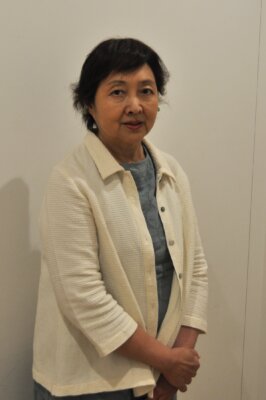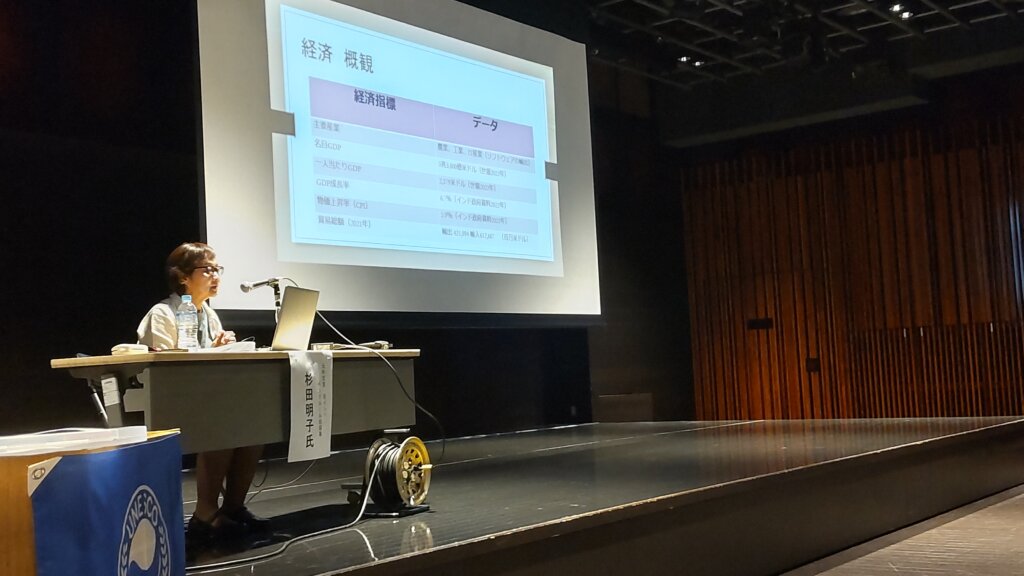Culture and Economy of South India
The First 2023 Cross-cultural Awareness Workshop
Culture and Economy of South India
Lecturer: Ms. SUGITA Akiko
Date: May 28, 2023 14:00~16:00
Venue: Minato City LIBRA Hall
Following President Tanabe’s greeting, the moderator introduced Ms. Sugita (pictured on the right: Previous Consul General of Bengaluru, India). There were approximately 100 audience.

1.India Overview
Its area is nine times larger than that of Japan, which is why it is called the Indian subcontinent. (7th place in the world). The population is 1,426,780,000. This year, it surpassed China to become the country with the largest population in the world. Although it is not well known, India sits in the 5th place in the world in terms of nominal GDP. It surpassed its former colonial power, Great Britain. Official terminology is Hindi, and English is a quasi-official language. There are many cases where communication is not established in English. 80% of people are Hindu. Only 0.7% are Buddhist.
Why did Buddhism become obsolete compared to Hinduism? While Buddhism developed based on the merchant class, Hinduism was believed by agricultural people. However, with the decline of the Roman Empire, the merchant class declined, and also, the Islamic powers that later ruled India did not tolerate idol worship like Buddhism, while Hinduism was protected. South Indian astrology said to have been written by Agastya, the founder of Tamil literature, is famous. It is said that the fate of all mankind is written on palm leaves. There is a place in Bengaluru city where Agastya leaves are read, and I myself found my own leaf there.
2.History of South India
The Dravidians migrated to northwestern India around 3500 BC, and, then, the Aryans around 1500 BC. The Dravidian people moved southward under the influence of the Aryan people. After the era of prosperity of the Three Kingdoms, the Chalukya dynasty flourished in the 6th century. From the 13th century to the mid-19th century, the Delhi Sultanate and the Mughal Empire were established in northern India, and many Indo-Islamic style buildings were built under the Mughal Empire.
One of the most famous is the Taj Mahal (a world heritage site) built under the Mughal Empire. In 1858, the British Raji was established and the Mughal Empire fell. In 1947, India became independent from Britain. The spirit of non-violence and disobedience of Mahatma Gandhi, who led the independence movement, has continued to this day, having great influence over the human rights movement around the world.
3.Food culture
A Hindu wedding is a big event. Hundreds to thousands of guests are invited over several days. Christian weddings are the same as in the West and seem to be held on just one day. People enjoy rich curry and piping hot naan or chapatis in North India. South India is the country of perpetual summer, and so people there enjoy light soup-like curry and Indica rice. People eat with the right hand. They roll up curry and rice in their hand and place it on their tongue. Also, masala dosa (rice flour and bean flour mixed with water and fried in the shape of a crepe) is a typical South Indian dish for breakfast. It’s delicious and cheap and is quite recommendable. Processed foods sold in cafeterias and stores are often marked whether they are for vegetarian or non-vegetarian.
4.Religion
Hinduism is believed, but it is also a “social custom” that is deeply rooted in society. Based on Hinduism the class and caste system consists of Brahmins (the subjects of rituals), Kshatriyas (royals and warriors), Vaishyas (Agriculture, Industry and Commerce), and Shudras (three types of servants). There are untouchables under these classes who are treated as unclean and are discriminated. They are not allowed to drink water from the same well. Ambedkar, the Minister of Justice from the untouchables, was the person who drafted the current constitution. Although class discrimination is prohibited in the constitution, there still exist honor killings against marriages with untouchables. Of Japan’s Seven Lucky Gods, Daikokuten, Bishamonten, and Benzaiten have their roots in Hinduism. It has many things in common with Shinto, and there is no founder or scripture and is polytheism.
5.Economy
GDP is 5th in the world, but it is expected to overtake Japan and become the third largest economy as early as in 2027. It is predicted that India will overtake the USA by 2050 and come in second place. Economic growth rate is predicted to be 5.9% in 2023. On the other hand, GDP per capita is low. It is said that 60% of the land is farmland, but the income is quite low with surplus labor.

In India the primary industry (agriculture) migrated into tertiary industry (service industry) before secondary industry (industrial/manufacturing) had well developed. When the year 2000 computer problem broke out, many Indians who speak English and have a strong background in mathematics and computer technology played an active role as the point of contact at help desks around the world, which is said to have triggered the development of Indian IT industry thereafter.
There is a My Number Card called “Aadar Card”, which is distributed to each of 1.4 billion people. It is linked to food distribution to the poor, pensions, etc. Digitalization of administration services is quite advanced, and 87% of the population owns a mobile phone. Especially e-commerce is well developed under the coronavirus pandemic, food and daily necessities can easily be ordered online and delivered. There are many start-up companies. (In India, where 15 million people are born every year, new industries are being created as young people seek jobs every year. It is necessary to grow the economy and create jobs).
The middle class expanded and consumption increased. India is a large market growing rapidly, which is quite attractive to Japan where the domestic market is shrinking due to population decline. However, as Japanese companies are very slow in decision making, they are losing out in competition to top-down Western European companies. It is said that Japanese companies which appoint Indian people as president and transfer the authority of decision making to him while appointing Japanese as a vice-president who is responsible for coordinating with main offices in Japan are mostly successful.
6.Diplomacy
Its foreign policy has traditionally been non-alignment and neutrality. Under the concept of FOIP (“Free and Open Indo-Pacific”) the country is promoting a Quad with Japan, the US, and Australia. It traditionally had friendly relations with Russia, while with China there is a sense of caution due to issues such as military clashes at the border in 2020 and market dominance by Chinese products.
7.Japan-India relations
India is an important partner for Japan. India enjoys rapid economic development and is Asia’s third largest economy. It also has a strong voice in the international community (among members of G20, BRICS, etc.). Huge population and the increase in the middle-income class is also important for the market. Stable government management continues, and there have been no coups since independence. It has a worldwide Indian network. Although it is necessary to strengthen mutual relations in the field of Japanese technology (e.g. introduction of the Shinkansen system) and Indian human resources (not only the IT industry but also nursing care, agriculture, and hospice), it is overwhelmingly weak compared to the exchanges between Japan and China. It is increasingly important to promote people-to-people exchanges with India and deepen mutual understanding.
(Q & A after the lecture)
In terms of daily life issues, the quality of tap water is very poor, and I had to brush my teeth with mineral water. I took a special care not to let tap water get into my mouth while taking shower.
The federal system is adopted. The country is responsible for India’s military, foreign policy, and economic policy. On the other hand, the state is responsible for infrastructure such as roads and subways that are important to the lives of state residents and responsible for local policies such as infection prevention measures during the coronavirus pandemic
As for the question whether the gap between rich and poor will continue, the number of people moving from the poor to the middle class is expected to increase as India’s economy develops. In order for India to develop, there lies a problem to solve that the development of road infrastructure is slow. It is necessary to eliminate political corruption hidden behind in the state government.
(Written by YAMADA Yuko, the International Science & Culture Committee, and translated by SUDA Yasushi, the PR & Internet Committee Associate)
